Coffee aficionados often debate the merits of different brewing methods, each with its own traditions and tastes. Among the various options, the Italian coffee maker, also known as the Moka pot, and the French press are two popular methods. Understanding how these devices work and the type of coffee they produce can help you decide which might suit your morning routine best.
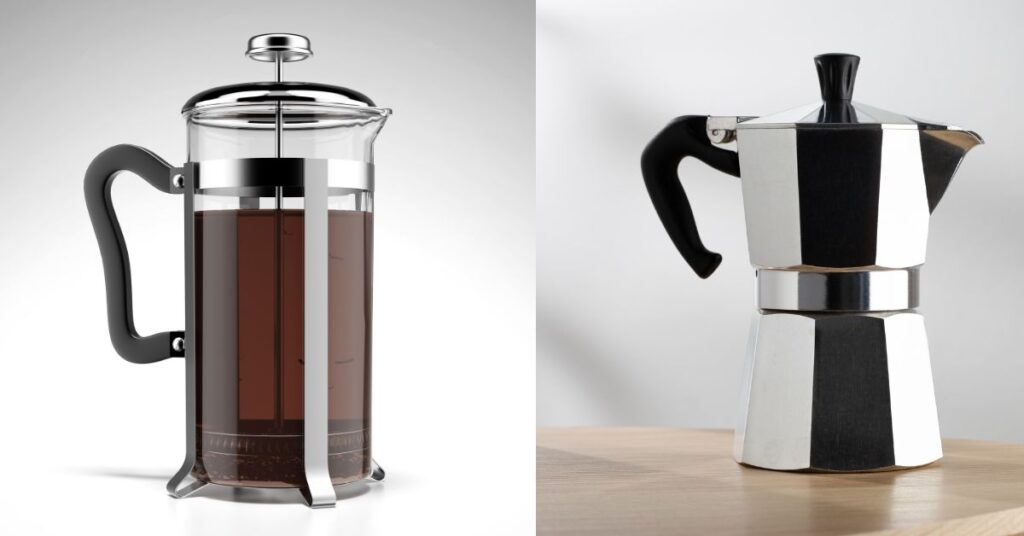
The Moka pot, a stovetop coffee maker invented by an Italian engineer in the 1930s, brews coffee by passing boiling water pressurized by steam through ground coffee. It’s known for producing strong, rich coffee with a consistency closer to that of espresso. On the other hand, the French press, also called a press pot or plunger pot, offers a more straightforward brewing method where coffee grounds steep directly in hot water before being separated by a mesh plunger.
Both methods have their devotees due to the distinct flavors and experiences they provide. Your preference might come down to the type of coffee you enjoy, the texture you prefer, or the time you wish to spend on brewing. The Italian Moka pot might take a bit more finesse to master, while the French press offers simplicity and a full-bodied brew. Understanding the nuances of each process could lead to a more enjoyable coffee experience tailored just for you.
The Basics of Brewing Coffee
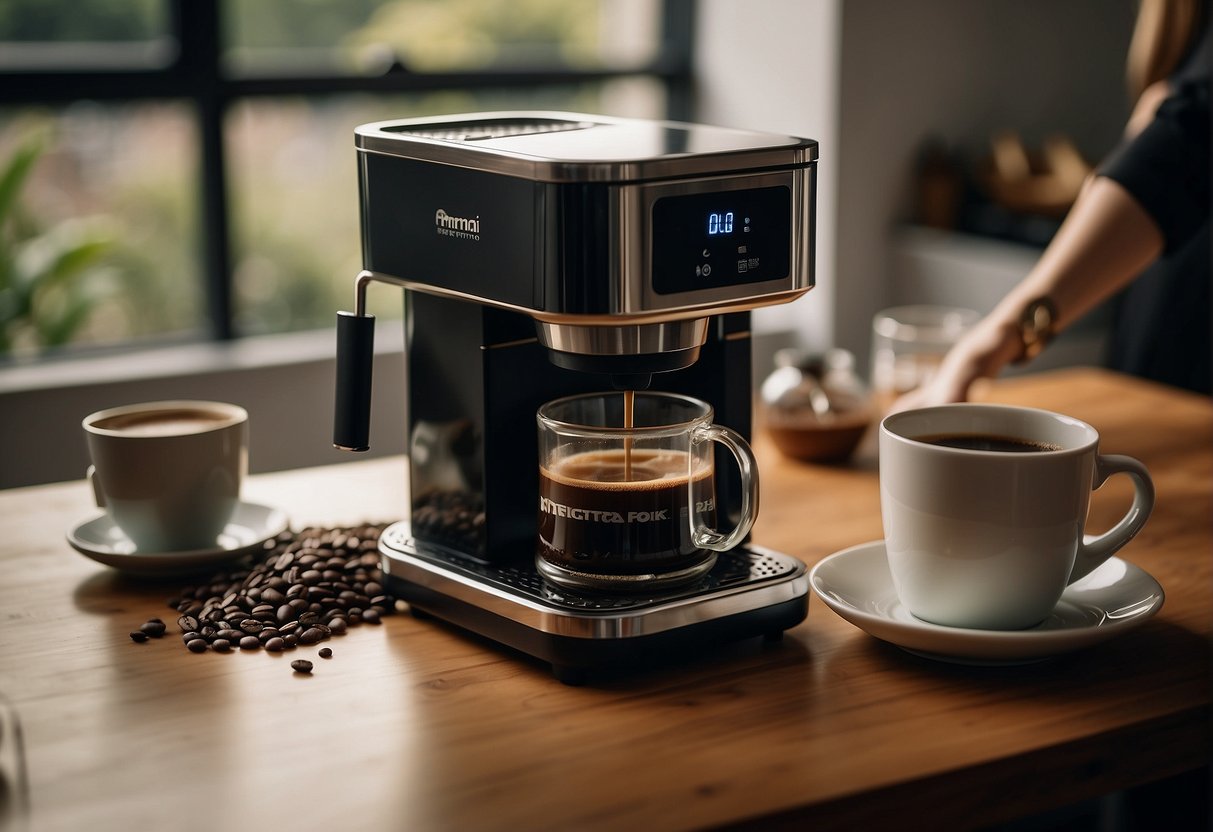
When you’re looking to brew the perfect cup, it’s essential to understand the basics of your coffee maker of choice. Whether you opt for an Italian coffee maker or a French press, each method involves hot water and coffee grounds to brew coffee, but they differ significantly in their approach.
Understanding Italian Coffee Maker
Italian coffee makers, commonly known as Moka pots, use steam pressure and heat from a stove to brew coffee. Follow these steps for your Italian coffee maker:
- Fill the Bottom Chamber: Pour hot water into the bottom chamber up to the safety valve.
- Add the Coffee Grounds: Place finely ground coffee into the filter basket. Level it off without tamping.
- Assemble and Heat: Screw the top and bottom together. Heat on a stove until you hear a gurgling sound, indicating the water has filtered through the grounds.
Note: Do not leave the Moka pot unattended, as it brews quickly once the water reaches the right temperature.
Grasping French Press Fundamentals
With a French press, you manually steep the coffee grounds in hot water and then separate them with a plunger. Here’s how to use your French press:
- Preheat Your French Press: Swirl some hot water in it, then discard that water.
- Add the Coffee Grounds: Use coarse grounds; they should look like breadcrumbs. For a strong brew, use a 1:15 coffee-to-water ratio.
- Pour in Hot Water: Fill with water just off the boil, ensuring all the grounds are saturated.
- Steep and Plunge: Let it steep for about 4 minutes, then press down the plunger slowly and evenly.
Tools like a burr grinder and a kitchen scale will help you obtain consistent results by giving you precise control over the grind size and amount of coffee.
Comparing Brewing Techniques
The Moka pot and French press use different methods to extract flavor from coffee grounds. Both rely on the quality of coffee used, but the brewing techniques apply heat and pressure in unique ways to produce distinct taste profiles.
Brewing Process for Moka Pot
Your Italian coffee maker, commonly known as a Moka Pot, consists of three main parts: the bottom chamber for water, the middle for coffee grounds, and the top chamber for your finished brew. Here’s how you brew coffee with a Moka pot:
- Fill the bottom chamber with water up to the safety valve.
- Place finely-ground coffee in the filter basket.
- Screw the sections together tightly and place on a heat source, like a stove.
As the water in the bottom chamber heats, pressure builds up and pushes the water upward through the coffee grounds. This process extracts strong and flavorful coffee into the top chamber, often with a slightly thicker consistency than drip coffee due to the small amount of pressure involved.
Steeping in a French Press
The French press method uses a steeping technique for brewing:
- Add coarsely-ground coffee to the French press carafe.
- Pour in hot water, ensuring all the coffee grounds are submerged.
After you pour the water, you’ll let the coffee steep for about 4 minutes. This allows the hot water to extract oils and flavors directly from the grounds without the influence of pressure. Once the steeping time is up, you’ll slowly press down the plunger, separating the grounds from the liquid. This method yields a full-bodied coffee, highlighting the beans’ natural flavors.
Design Features and Materials
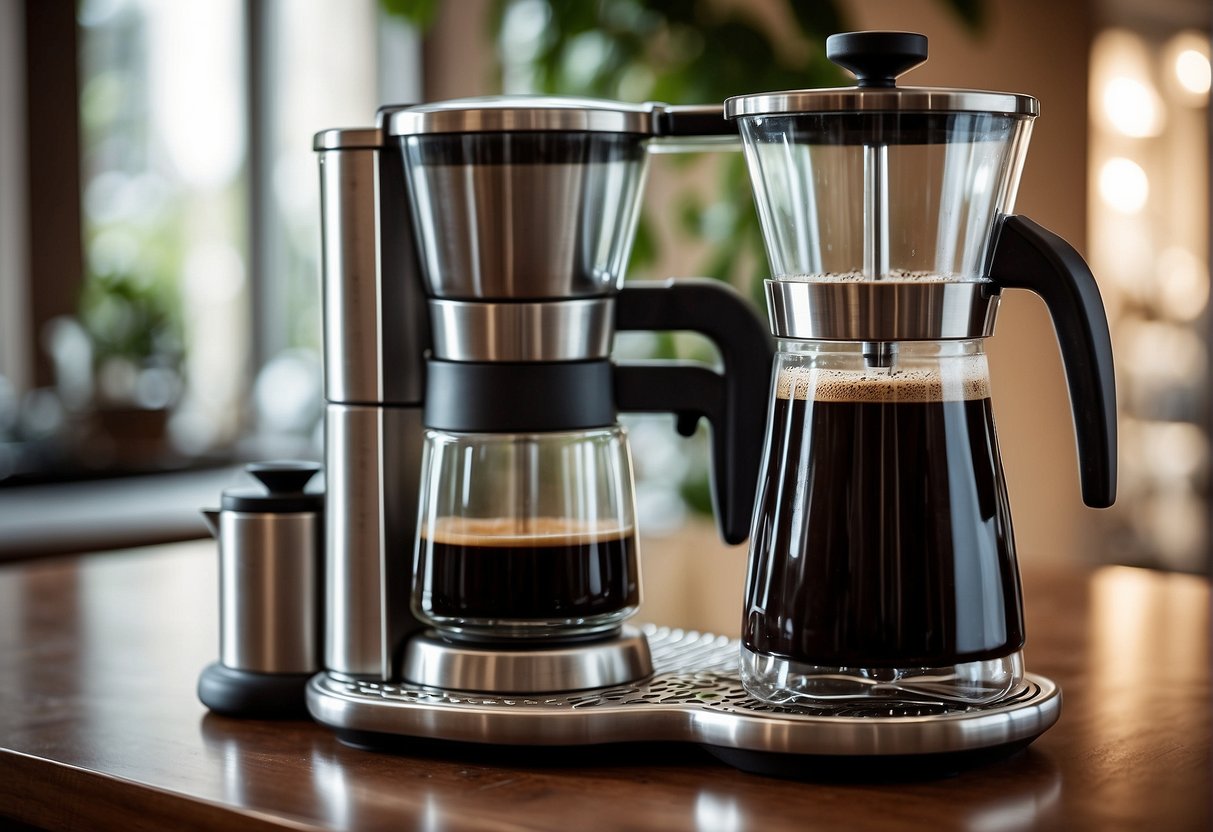
When you’re trying to decide between an Italian coffee maker and a French press, understanding the design features and materials of each can help you make an informed choice. Each has unique components that contribute to the brewing process and the overall user experience.
Italian Coffee Maker Design
The Italian coffee maker, commonly known as a moka pot, consists of a distinctive three-part design.
- Bottom Chamber: Your moka pot’s bottom chamber is made of aluminum or stainless steel and serves as the reservoir for water. It’s crucial to fill it just below the safety valve to avoid overpressurization.
- Top Chamber: The brewed coffee collects in the top chamber, which can be made from the same materials as the bottom chamber for durability and flavor preservation.
- Filter Basket: Sandwiched between these two chambers, you’ll find the filter basket where you add the ground coffee. The ground coffee never comes into direct contact with the bottom chamber’s water, promoting an indirect brewing method.
These components work together when heated on a stove, using pressure to push water through the coffee grounds and into the top chamber, where your brew is ready to be served.
French Press Components
In contrast, the French press uses a more direct immersion brewing method with these key parts:
- Carafe: Typically made of glass or sometimes stainless steel, the carafe holds your coffee grounds and hot water together. The transparency of glass lets you appreciate the brewing process, but a stainless steel carafe offers more durability.
- Lid: Sealing the carafe with the lid helps to maintain the temperature and begins the steeping process.
- Plunger: Attached to the lid, the plunger is pressed down after the coffee has steeped and uses a mesh filter to separate the grounds from the liquid. It’s a simple yet effective way to filter your brew without needing paper filters.
Each French press component plays a vital role in ensuring that your coffee has the right extraction time and filtering for a full-bodied cup.
Flavor Profile and Texture
When choosing between an Italian coffee maker and a French press, you’ll notice distinct differences in the flavor profile and texture of your coffee. These differences are a result of the varying brewing methods and the interaction between the coffee grounds and water.
Taste of Italian Coffee Maker Brew
Italian coffee makers, often referred to as Moka pots, produce a strong and concentrated cup reminiscent of espresso. The flavor is robust, given that the water passes through the coffee grounds under pressure, extracting a rich and full-bodied taste. Expect less of the natural oils to be present in your cup, as the metal filter of an Italian coffee maker is fine, allowing for a cleaner brew with less residue.
- Flavor: Robust, strong
- Texture: Smooth, concentrated
Flavor of French Press Coffee
The French press, on the other hand, brews a full-bodied cup of coffee that excels in preserving the coffee’s natural oils. These oils contribute to the coffee’s overall flavor which is often described as rich and saturated. The brewing process allows for a longer steeping time, which results in a deeper extraction of flavor. Unlike the Italian coffee maker, the French press’ metal mesh filter lets through more of the coffee’s natural oils, some fine grounds, and sediments, giving the final brew a full-bodied texture.
- Flavor: Deep, rich
- Texture: Oily, full-bodied
Practical Considerations
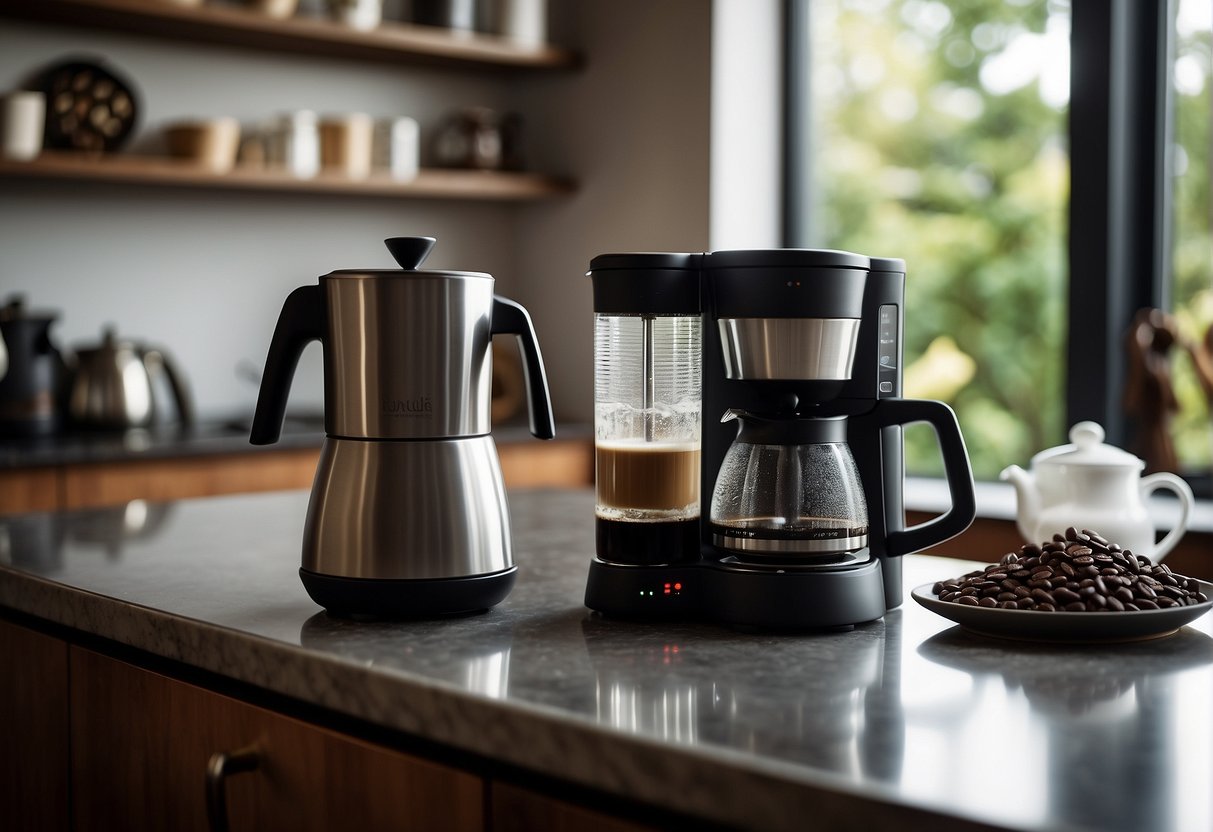
When choosing between an Italian coffee maker and a French press, consider how each fits into your daily routine, from preparation to cleaning.
Ease of Use and Cleaning
Italian Coffee Maker:
- You’ll find that an Italian coffee maker, often referred to as a Moka pot, requires a bit of finesse to assemble and operate. It consists of a bottom chamber filled with water, a coffee basket for the grounds, and an upper chamber for the finished brew.
- Cleaning is straightforward but involves disassembling all parts and washing them individually, ensuring no grounds are left to tarnish future brews.
French Press:
- Simplicity is a hallmark of the French press. Simply add coffee grounds, pour hot water, stir, wait for it to brew, and press. The lack of complicated parts or electronics makes it very easy to use.
- When it comes to cleaning, a French press can be a little less simple due to the need to remove coffee grounds from the mesh plunger. However, most components are dishwasher safe.
Portability and Size
Italian Coffee Maker:
- Generally compact, Italian coffee makers are made of durable materials like aluminum or stainless steel. They are not as portable due to their reliance on a heat source to operate.
| Sizes | Capacity |
|---|---|
| Small | 1-2 cups |
| Medium | 3-6 cups |
| Large | 9+ cups |
French Press:
- A French press is often more portable and comes in various materials, including plastic, which is ideal for travel. No electricity or heat source is needed directly, as you can utilize pre-boiled water from any source.
| Sizes | Capacity |
|---|---|
| Mini | 1 cup |
| Standard | 3-4 cups |
| Large | 5+ cups |
Cost Differences
Italian Coffee Maker:
- Costs vary by brand and material, but an Italian coffee maker is a moderately affordable option.
| Material | Price Range |
|---|---|
| Aluminum | $15 – $25 |
| Stainless Steel | $20 – $50 |
French Press:
- The French press is known for its affordability. Basic models start at around $10, with premium versions reaching up to $100 for those crafted with higher-end materials or designs.
| Material | Price Range |
|---|---|
| Plastic | $10 – $20 |
| Glass | $15 – $30 |
| Stainless Steel | $20 – $100 |
Frequently Asked Questions
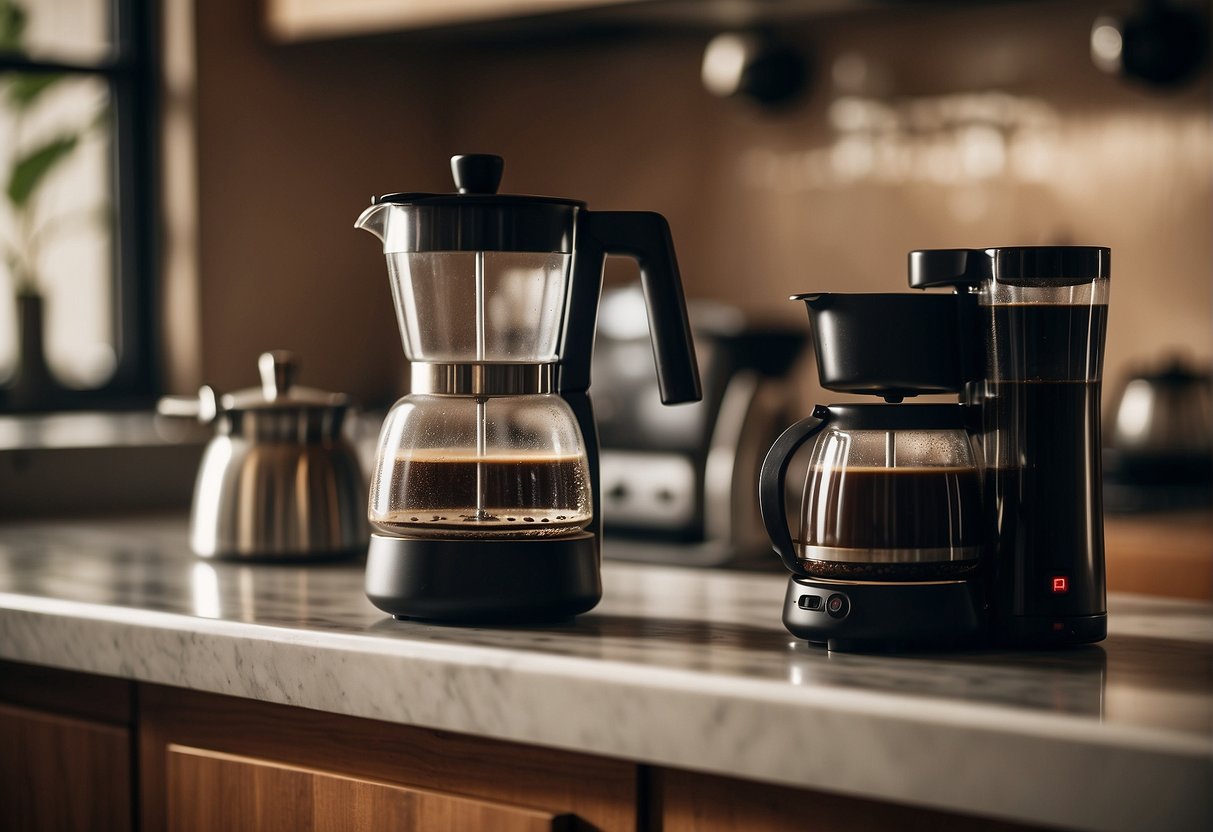
In this section, you’ll find clear answers to common questions about Italian coffee makers and French presses, helping you to understand their differences, taste profiles, strength, operation, ease of use, cleanup, and caffeine content.
What are the main differences between Italian coffee makers and French presses?
Italian coffee makers, also known as Moka pots, brew coffee by passing boiling water pressurized by steam through coffee grounds. French presses, on the other hand, steep coffee grounds in hot water and use a plunger to filter the coffee.
How does the taste of coffee from an Italian coffee maker compare to that from a French press?
Coffee from an Italian coffee maker is typically rich and strong, similar to espresso, with a layer of crema on top. French press coffee has a fuller body and can bring out more of the coffee’s natural oils, resulting in a different flavor profile.
Can you get stronger coffee from a French press than an Italian coffee maker?
It’s possible to brew stronger coffee with a French press by adjusting the brew time and coffee-to-water ratio. However, an Italian coffee maker is generally designed to produce a concentrated brew similar in strength to traditional espresso.
What is the Italian equivalent to a French press, and how do they work?
The Italian equivalent to a French press is the Moka pot. It brews coffee by heating water in the lower chamber, which forces steam through ground coffee held in a filter basket, into an upper chamber where the coffee collects.
When considering ease of use and cleanup, which is more user-friendly: Italian coffee makers or French presses?
French presses might be more user-friendly to some due to their simple design with fewer parts, making them straightforward to use and clean. Italian coffee makers have several components that require assembly and disassembly, which might complicate the process.
Does the caffeine content differ between coffee made with an Italian coffee maker and a French press?
The caffeine content in coffee can vary with both methods depending primarily on the coffee-to-water ratio and the type of coffee grounds used. Using the same type of coffee, a French press allows more control over extraction time, which can affect caffeine levels.
